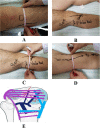An analysis on the effect of the three-incision combined approach for complex fracture of tibial plateau involving the posterolateral tibial plateau
- PMID: 32046762
- PMCID: PMC7014713
- DOI: 10.1186/s13018-020-1572-4
An analysis on the effect of the three-incision combined approach for complex fracture of tibial plateau involving the posterolateral tibial plateau
Abstract
Background: The clinical effect of the three-incision combined approach for complex fracture of tibial plateau involving the posterior tibial plateau was discussed.
Methods: A retrospective analysis was performed for 13 cases receiving surgery for complex fracture of tibial plateau from July 2015 to June 2019. They received surgery via the three-incision combined approach, and regular postoperative reexamination was performed at the outpatient clinic. During the last follow-up, Hospital for Special Surgery (HSS) Knee Scoring System was used to assess the knee joint function; the Lysholm score was used to assess the knee mobility. The anterior, posterior, and rotational stabilities of the knee joint were assessed by the Lachman test and pivot-shift test.
Results: There was no nonunion and delayed union, implant loosening and fracture, or refracture, and neither were there neurological symptoms or restricted mobility in daily life. During the follow-up, none of the cases were found with restriction of knee mobility caused by internal fixation or apparent pain. The HSS score during the last follow-up was 86-100 (average, 90.2 ± 6.8), and the excellent and good rate was 100%; the Lysholm score was 86-100 (average, 95.7 ± 2.6). All cases were negative for the Lachman test and pivot-shift test. The knee flexion mobility was 100~140° (average, 127.2° ± 11.4°). Postoperative X-ray indicated anatomical reduction of bone fractures in all cases. Loss of reduction or loosening and fracture of internal fixation was not observed by postoperative regular reexaminations. The posterior tibial slope at 6 months after surgery was 6~16° (average, 10.66 ± 2.58°), the varus angle was 84~89° (average, 86.52 ± 1.46°), the Rasmussen radiological score was 12~18 (average, 16.12 ± 1.35), and the excellent and good rate was 100%.
Conclusion: The three-incision combined approach proved safe and reliable for complex fracture of tibial plateau involving the posterior tibial plateau and is worthy of further popularization.
Keywords: Combined incision; Internal fracture fixation; Knee joint; Tibial fracture.
Conflict of interest statement
The authors declare that they have no competing interests.
Figures


Similar articles
-
Surgical Treatment of Lateral Tibial Plateau Fractures Involving the Posterolateral Column.Orthop Surg. 2019 Dec;11(6):1029-1038. doi: 10.1111/os.12544. Epub 2019 Nov 6. Orthop Surg. 2019. PMID: 31693310 Free PMC article.
-
Surgical Strategy for Anterior Tibial Plateau Fractures in Hyperextension Knee Injuries.Orthop Surg. 2021 May;13(3):966-978. doi: 10.1111/os.12997. Epub 2021 Apr 4. Orthop Surg. 2021. PMID: 33817977 Free PMC article.
-
Treatment of posterolateral tibial plateau fractures with a rotational support plate and special pressurizer: technical note and retrospective case series.J Orthop Surg Res. 2021 Jun 23;16(1):407. doi: 10.1186/s13018-021-02544-w. J Orthop Surg Res. 2021. PMID: 34162413 Free PMC article.
-
Fibular head osteotomy: a new approach for the treatment of lateral or posterolateral tibial plateau fractures.Knee. 2010 Oct;17(5):313-8. doi: 10.1016/j.knee.2010.01.002. Epub 2010 Feb 18. Knee. 2010. PMID: 20163966 Review.
-
Diagnosis and Treatment of Anterior Tibial Plateau Fracture-Dislocation: A Case Series and Literature Review.J Knee Surg. 2017 Feb;30(2):114-120. doi: 10.1055/s-0036-1581136. Epub 2016 Apr 27. J Knee Surg. 2017. PMID: 27119967 Review.
Cited by
-
Long-term surgical outcomes of open reduction and internal fixation (ORIF) in patients with Hoffa-like tibial plateau fractures: a clinical study and analysis.Int Orthop. 2024 Dec;48(12):3237-3243. doi: 10.1007/s00264-024-06315-0. Epub 2024 Sep 23. Int Orthop. 2024. PMID: 39311893
-
Determination of Posterior Tibial Slope Changes After Tibial Plateau Fracture Fixation: A Retrospective Case Series.Indian J Orthop. 2023 Aug 10;57(9):1485-1489. doi: 10.1007/s43465-023-00960-0. eCollection 2023 Sep. Indian J Orthop. 2023. PMID: 37609018 Free PMC article.
References
-
- Langford JR, Jacofsky DJ, Haidukewych GJ. Tibial plateau fractures [M]//Scott WN. Isall & Scott Surgery of the knee. 5th. Philadelphia: Churchill Livingstine, 2011: 773–785.
-
- Moore TM. Fracture-dislocation of the knee. Clin Orthop Relat Res. 1981;156:128–140. - PubMed
-
- Luo CF, Hu CF, Gao H, et al. Three-column classification for tibial plateau fractures. Chin J Orthop Trauma. 2009;11(3):201–205.
-
- Zhu Y, Luo CF, Yang G, et al. Three-column classification for fracture of tibial plateau and the related reliability assessment. Chin J Orthop. 2012;32(3):254–259.
MeSH terms
LinkOut - more resources
Full Text Sources
Medical

